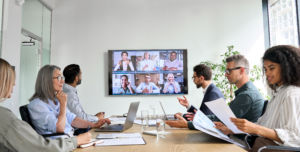Over the past 16 months of the pandemic, we have learned to run meetings and present in the virtual platform environment – new skills for sharing your screen, engaging an online audience, and mastering “chat.” These built on the in-room skills from in-person days – delivery techniques for working with the screen, eye contact, and fielding Q&A.
It’s now time to master the hybrid environment as we begin returning to the office – a mix of presenting to colleagues and customers in a physical room and still engaging those who are working remotely. In reality, many organizations have been doing this for years, with most remote participants on a conference call line instead of a video link. The pandemic forced a technological jump, where teams expect video to be a component for virtually every meeting.
Here are questions to consider, with answers to come from IT and A/V technicians:
- Can the presenter be on camera? It’s best to have a face for the remote audience along with the slide deck and audio.
- Is there technology available for presentersto engage with the remote audience? Typical examples are PowerPoint slide builds, short video clips, interactive websites, and participant voting or polling.
- How will the remote audience ask questions?
- For interactive discussions, who will get to make comments and ask questions first, remote or in-person?
Read our Tips to Hold a Successful Online Meeting and Six Tips for Your Next Virtual Meeting for more practical ideas to help you manage your virtual and synchronous online meetings.
In the spirit of comedian Jeff Foxworthy’s gameshow, “Are You Smarter than a Fifth Grader,” we take a page from elementary school teachers who have been working in the hybrid environment for the past school year. Here are their tips to for a successful hybrid meeting:
- Co-Seating: In the classroom with a mix of in-person and virtual, the teacher assigns each virtual participant an in-person attendee. This keeps the instructor focused on the big picture and allows remote participants to send a chat to their co-seat with questions or clarifications. Without co-seating, the instructor can get interrupted many times with mundane questions like: Can you repeat that?’ or “I can’t read that 3rd bullet.”
- It’s Not All Business: When the pandemic first began, we were better at checking in to make sure we were doing okay. This is still important, especially for the virtual audience who has less interaction with work colleagues.
- Engage the Entire Audience: It takes more work to get reaction from the virtual group. Assuming in-person and virtual audience has their laptops open:
- Ask closed ended polling questions.
- Use apps such as PadLet, which creates virtual sticky notes on the screen to help share ideas and reach consensus.



